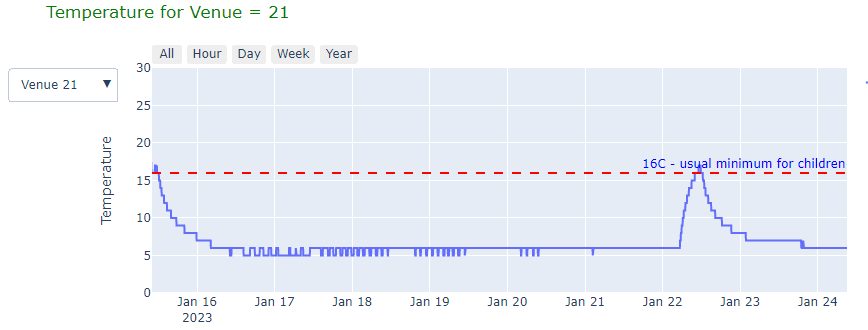Observing setback thermostat operation#
Some venues have a thermostat that enforces a setback temperature, or setpoint. This is a minimum air temperature for a space. This could be done from the main thermostat, but it might be a second thermostat. If it’s a second one, some people might refer to it as the “frost stat”.
If the space drops below the setback temperature, that will bring the heating on until it rises above the setback temperature even if there’s no other reason for the space to be heated.
A setback thermostat kicking in looks like this:

The temperature as shown on the thermal monitor doesn’t stay exactly the same at all times. This is because
the thermostat lets the actual temperature vary by a degree or two around the setpoint.
the thermal monitor isn’t in exactly the same location as the thermostat.
There’s no guarantee this is really a setback thermostat - it could just be the weather outside happens to hold the temperature in the space exactly right. However, flat lines for a long time are not typical, at least for older or leakier buildings. Usually between heating sessions, the indoor temperature will keep dropping more and more slowly until it reaches a floor the same amount above the external temperature every time and then vary slowly with the weather.
Enforcing a setback temperature can be important for preserving the building and contents in a building that isn’t heated very often, although it isn’t always needed. It depends on what’s in the building, how well-ventilated the building is, and whether the way the building is operated makes low indoor temperatures and high relative humidity unlikely. Paintings (including frescos) might require relatively high temperatures, say 14C. Stained glass will leach chemicals that degrade the colours if the temperature of the glass reaches dewpoint, when condensation will form; there appears to be a general rule of thumb that for a typical church in typical church use, 7-8C is safe. There is some current discussion about whether with very good ventilation in a building that has nothing special, lower would do - a strategy that works well with localised heating but not with space heating or frequent use. It’s always best to discuss the requirements with your architect, and can also be worth asking how they’ve come to an answer!
